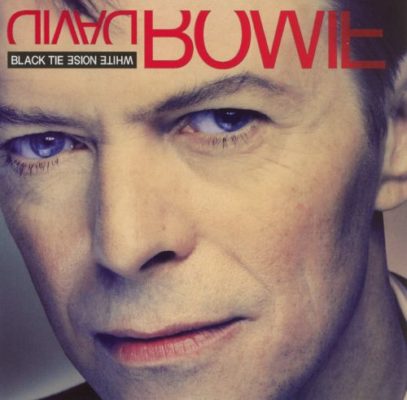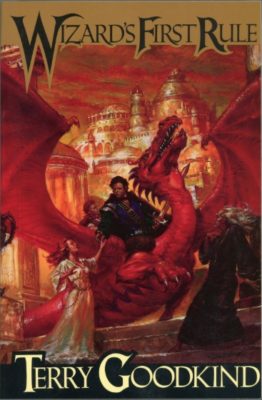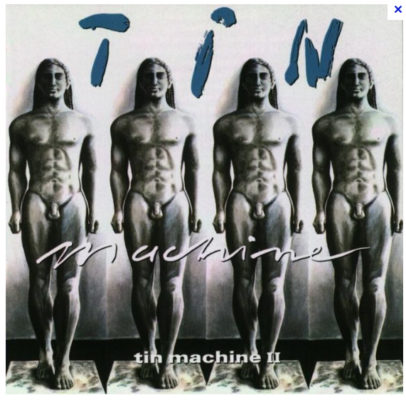Black Tie, White Noise is legendary, and not just for having a punchable album cover. When it came out in 1993, it marked Bowie’s return from the wilderness – his first solo album in six years. Just try holding your breath for six years – I bet you can’t do it. You probably won’t even make it halfway.
Bowie spared no effort in trying to tank it. He re-united with Let’s Dance producer Nile Rogers, who recounts baffling self-sabotage inside the studio. A potential smash hit (the Madonna-ripping “Lucy Can’t Dance”) was demoted to a mere bonus track. The final tracklist seems to emphasize the artistic and non-commercial songs, particularly a piece composed for David’s wedding to Somali fashion model Iman.
BTWN is a cold, funky dance record. They pulled 70s disco out of cryogenic suspension, partly thawed it, and added some 90s production elements. The album contains the snappy, bright Cheiron Studios sound that was all over the charts at the time, along with sampled beats and grafts from jazz and swing. At first the album’s sonics impress (as Let’s Dance‘s did), but soon you want to hear distorted guitars, and roughness, and humanity. BTWN is too clean. Actually, it’s germophobic.
A couple of the songs connect with me. “They Say Jump” delves into societal pressure through the metaphor of Bowie’s half-brother Terry, who had committed suicide some years before. It’s the closing parenthesis to “The Bewlay Brothers”. “Nite Flights” is a cover of a Scott Walker song, adding lots of air to what was already a large and generous-sounding arrangement. And “Pallas Athena” is a furious and crushing dance track, woven out of thudding drums and stentorian vocal samples.
The title track is a self-conscious aping of “Fame” from Young Americans. Carlos Alomar’s riff is replaced by a funky slap-bass part, the descending “fame”s at the end replaced by ascending “yow-yow-yows” at the beginning, John Lennon replaced by someone called Al B Sure! (whose career spiraled the drain after doing this collaboration). The half-rapped ostinato (“Black! Tie! White! Noise!”) is quite good, although I could do without the “crankin’ out the white noy-oy-oise” chorus.
The lyrics are McCartney’s “Ebony and Ivory”: a guilty white guy talking about how mankind is a beautiful rainbow, with a black musician dutifully playing Br’er Rastus in his minstrel show. I always dislike these types of songs, mostly they’re never as brave as they think they are. “I’m a face, not just a race!” Bold words in 1993. The lyrics reference the Rodney King riots, but still end with all the usual cliches of black and white man holding hands and becoming one. You know what I’d like to hear? A song that’s about how different we are. That maybe black and white aren’t the same, and we need to come to terms with that in whatever way we can. It would be career suicide, but at least it would be a fresh take on things.
The rest of the album is unmemorable. What artistry it has overwhelmed by a driving sleet of digital breakbeats and pad synths. Bowie’s vocal melodies are slender things, unable to support the weight of the arrangements. To be blunt, I don’t need to listen to Bowie for 56 minutes straight, nor do I need to hear about his wedding. The tacky “modern” elements just emphasise how little of the old Bowie is present on the album.
Comparisons can be drawn to another album, twenty years earlier, when Bowie was also newly married. But where The Man Who Sold the World became a classic, Black Tie, White Noise is sadly the first of many inconsistent and often uninteresting 90s efforts.
No Comments »
Terry Goodkind doesn’t seem particularly good or kind, although he’s definitely a Terry, so one out of three isn’t bad.
He is also not a fantasy author. It’s very important that you know this. Despite where he’s shelved in bookstores, despite what mythical creatures appear on his covers, he is not a fantasy author. Sample from this non-fantasy novel: “Magic!” the dragon gasped in mock fright. It put a claw to its breast. “Oh, please, brave man, don’t slay me with your magic sword!” It made a smoky rumble that Richard took for laughter.
In an infamous 2003 interview with USA Today, Goodkind responded to a question about Robert Jordan with “If you notice a similarity, then you probably aren’t old enough to read my books”. Jordan’s wizards, magic, and dragons are expressions of juvenilia, while Goodkind’s are an exploration of human truth, or something. Massachusetts-based grindcore band AxCx wrote a song called “Face it, You’re a Metal Band”. I wrote the previous sentence for no reason.
Goodkind is inseparable from early 90s fantasy, and a time when the genre was never more tedious, bloated, or unnecessary. Terry Brooks, Raymond E Feist, David Eddings were producing retreads of their past series, and Robert Jordan had begun work the massive monument to dead trees known as the Wheel of Time. So many huge fantasy books were released that bookstore shelves probably remember the era the way Cambodians remember the Khmer Rouge – a time of great suffering, where only the strong survived. In this market, Goodkind’s 900-page doorstoppers immediately found readers.
But what about the book?
The plot establishes a typical monomyth: young Richard Cypher is appointed as “Seeker” and must save a woman from the villainous Darken Rahl, who may need to work on his branding.
When I read it at age twelve, I was soon bored. The story wasn’t moving, and Goodkind has an astonishing ability to create confusion: a wizard character infodumps for thousands of words about what, exactly, a Seeker does, and I left the passage more perplexed than ever.
But then the pace picks up, and Wizard’s First Rule shows its colors as a violent, gritty human interest story of the kind that bloggers ten years later would call “grimdark”. It lacks the impact and power of George RR Martin’s books (in particularly, it’s not believable that the comically evil villain gets so many people on his side), but it’s still well beyond Jordan.
In particular, Goodkind seems to like rape. I don’t believe there’s a single female character in the book, if not the entire series, who isn’t raped or threatened with rape at some point. Two thirds of the way through, the plot takes an excessive but audacious turn into outright Gor territory, with Richard enslaved to a leather-clad dominatrix. This is probably the moment where Goodkind finally lives up to his “mature Jordan” claim. I’m conflicted on this part: it strangely works, giving Richard some of the most severe but effective character moments I’ve yet read in a fantasy book. But it also reads like a Gor book.
Even at its best, Goodkind’s work are foothills to GRRM’s mountains. His worldbuilding makes no sense: it’s established that fire is forbidden in Darken Rahl’s kingdom, but they seem to have no problems forging weapons, making pottery, cooking food, and so on. Writer’s convenience abounds: the typical way you escape danger in Goodkind’s books is to use or discover some new piece of magic that was never mentioned before.
I don’t recommend the books after three or four, which delve ever deeper into mumblecore obscurantism and Goodkind’s political opinions (he likes Ayn Rand). But the early ones do, in fact, have entertainment value, although I appreciate them as spectacle more than literature. Terry Goodkind might not be a fantasy author, but he’s not an entirely bad one, either.
No Comments »
There was a fool-me-once quality to Tin Machine’s debut. Overlong, overloud, “artistic” in all the wrong ways, initially it had strong sales (unlike the bass and drums, which had rather the opposite), but the singles gained no traction, and it soon slid from the charts. When Bowie presented EMI with a follow-up, the label refused to release it.
Tin Machine II was finally issued in 1991 by fly-by-night Japanese label Victory Records. This time, nobody indulged Bowie’s vanity project. The press it received was scornful, and the album stalled out at #23 on the UK charts. For six months the band stubbornly toured it to thousand-seat venues, Bowie rapidly burning through his savings in the process. By the end of the tour, Hunt Sales’s drug addiction made it intolerable to go on, and by 1994 the band was over.
It’s a shame, because II is better than I. Time had forged the band into something stronger than their parts: Hunt Sales no longer buries the songs under drum fills, Reeves Gabrels has dialed back the noise, and David shows up with some of his best songwriting in half a decade.
Opener “Baby Universal” is a star witness in the case that the Machine deserved to exist. Driving and punishing: this song has no fat or wasted moments. Curiously, this was written in the earliest days of Tin Machine, before the Sales brothers joined the project. Bowie delivered his best work in a narrow set of circumstances: him and a collaborator, alone. Aside from the Spiders, he rarely benefited from a full band.
Other cuts like “You Belong in Rock and Roll” and “Amlapura” also present David’s maligned new project in a more positive light. The lyrics go to dark places, particularly “Shopping for Girls”, which is about Reeves Gabrels’ encounters with child prostitutes in Thailand (for an article, natch). They’re more diverse: the guitars shimmer and splash rather than just grinding like a rusty gate, and the songwriting has a bit of dynamism to it: it’s flowing water, where TMI was a series of stagnant and scum-encrusted pools.
Which is not to say TMII belongs with the best Bowie albums, or the mid-rank. “One Shot” is just obnoxious, laughably oversung by Bowie, with awful Europop “wooo-hoo-hoo” backing vocals from Tony Hunt. Astonishingly, this was a single. Perhaps Victory wanted their customers to have a beer coaster. “Stateside” is musical irrelevance personified. “A Big Hurt” is an unconvincing dad-rock take on hardcore punk.
The direst moment is “Sorry”, a musical head cold with Hunt Sales on vocals. He sounds terrible, the music meanders, and the whole thing prays to be on a floor of a cutting room variety.
Just as TMII seems to be gassing out, it delivers the greatest song in the band’s existence and the best thing David Bowie wrote in ten years. “Goodbye Mr Ed” is a threnody sung in the ruins of rock. Bowie’s vocals are both haunted and disaffected: the sound of a man demon-haunted for so long that terror has yielded to weariness. The massive ritardando capping each chorus has almost heart-freezing power, and the song ends with a crazy free-time jam from Gabrels and the Hunts. This time, it doesn’t sound comical or self-indulgent.
It wasn’t enough. Tin Machine II flopped, what little attention it got mostly revolving around the dicks on the cover. Bowie didn’t know it, but the 1991 was going to kill his band. Nirvana’s Nevermind (containing a more polished edition of Tin Machine’s noisy sound, and ironically, another cover with a dick) would come out in a few months, and instantly make Tin Machine seem tired and irrelevant. The grunge movement reshaped the musical landscape, burying artists like Tin Machine like fossils in the rock stratum of history. Faced with young and hungry bands from Seattle, there was nowhere for Bowie to go except the door.
Sometimes people survive trauma, only to die in their beds or in an ambulance. Tin Machine ambled on for a few more years, but the death blow happened in 1991. Tragically, that’s the year they made an album proving they deserved better.
No Comments »



